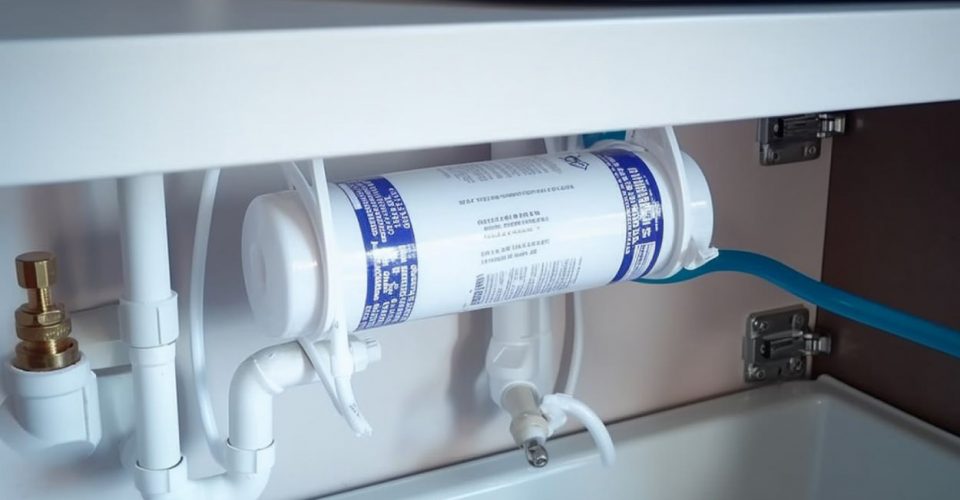How to Install an Inline Water Filter
If you’ve decided your water at home isn’t good enough, the next step is to decide which filter you need.
People with city water often opt for inline water filters. They get rid of low levels of common contaminants and can improve the taste of your water and luckily, they’re simple to install, too.
Let’s look at how they work and how you can install an inline water filter in your kitchen within an hour or two.

Understanding the Basics of Inline Water Filters
Inline water filters are like the unsung heroes of water purification. Compact, efficient, and designed to be installed directly within your water supply line, these filters work silently behind the scenes to deliver clean, great-tasting water right from your tap.
Let’s break it down: These filters use a variety of filtering mediums, such as activated carbon or ceramic, to trap and remove impurities in your water. Imagine a security checkpoint at an airport – just like how security personnel scrutinize every bag to ensure no prohibited items get through; these filters scrutinize every drop of water that passes through them.
The result? Water that’s free from chlorine taste and odor, sediment, and other unwanted elements. The effectiveness of an inline water filter can be likened to the quality of the security personnel – the better the filtering medium and the slower the water flow, the more thorough the filtration.
Essential Tools for Inline Water Filter Installation
When it comes to installing an inline water filter, having the right tools on hand is crucial. These tools make the job easier and ensure a successful installation. Here are the primary tools you’ll need:
Tools for Installation:
- Adjustable Wrenches: These versatile tools come in handy when dealing with various sizes of nuts and bolts in the filter system. No matter the size of your filter’s fittings, an adjustable wrench can adapt to suit your needs.
- Teflon Tape: This is your key to a leak-free installation. By applying Teflon tape to the threads of your connections, you create a watertight seal that prevents potential leaks and ensures the longevity of your filter system.
- Tubing Cutter: This tool is essential for accurately cutting your water line. It allows you to ensure a perfect fit for your filter, which is critical for proper operation.
In addition to these physical tools, you’ll also need a good dose of patience and confidence. Installing a water filter can be a detailed task, but with careful execution of each step, you’ll have clean, filtered water and the satisfaction of a job well done.
A Simple Guide to Installing Your Inline Water Filter
Here’s a step-by-step guide to help you through the process, ensuring safe and clean water flows from your taps.
Optional: Some inline filters come with an ‘easy change’ filter housing, which you can attach to your wall – in this case, you’ll need to attach this to your wall first. Home Water Research recommends some easy change models that allow you to change filters in seconds.
- Turn Off Water Supply: Locate your water supply and turn it off to prevent flooding.
- Prepare Pipe: Identify and mark the installation area on the pipe. Carefully cut the pipe according to your filter’s dimensions.
- Install the Filter: Connect the filter to the cut pipe section, ensuring the water flow direction matches the arrow on the filter. Use compression fittings to secure the connection.
- Turn On Water Supply: Turn the water supply back on and check for leaks. Smooth water flow indicates a successful installation.
- Test the Filtered Water: Test the filtered water to ensure purity. Some filters require flushing as per the manual.
Safety Measures During Installation
To ensure safety and optimal performance, consider these measures:
- Disconnect the water pump’s power before installation to prevent water surges.
- Use appropriate tools to avoid equipment damage and injuries.
- Keep the installation area dry to prevent slipping and damage.
- Follow the manufacturer’s instructions meticulously for safe and efficient installation.
- Check for leaks post-installation to prevent water wastage and damage.
Troubleshooting Common Installation Issues
Leakages
Check connections and follow instructions; consider reinstallation.
Water Flow Issues
Ensure the water supply and water pressure and inspect for blockages or damage.
Defective Unit
If problems persist, the unit might be defective and need replacement. Simple solutions like tightening connections and adjusting water pressure can often resolve issues. Follow the manufacturer’s guidelines for best results.
Maintaining Your Inline Water Filter Post-Installation
Maintenance is crucial for performance and longevity:
- Regularly monitor water flow changes.
- Follow the manufacturer’s filter replacement schedule.
- Clean the outer casing to prevent debris buildup.
- Inspect housing for leaks or cracks.
- Periodically test filtered water quality.
Conclusion
Understanding inline water filters is vital for successful installation and maintenance. With this knowledge and regular upkeep, you can provide your family with clean, safe water for years to come.

